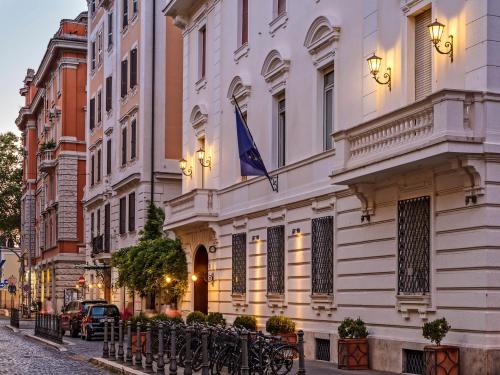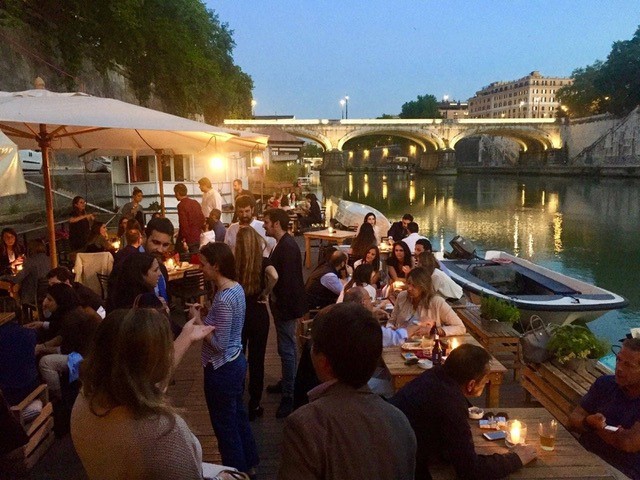









Castel Sant'Angelo Inn
Vous pensez qu'il y a une erreur sur ce lieu ?
Signaler une erreur
Vos retours sont importants pour nous. Si vous avez remarqué une erreur concernant ce lieu, merci de nous en informer pour que nous puissions la corriger.
Propriétaire de ce lieu ?
Nous récupérons automatiquement les informations disponibles sur votre lieu. Si jamais celles-ci ne sont pas correctes, connectez-vous gratuitement sur notre tableau de bord pour les modifier et bonus, accédez à vos statistiques détaillées.
Ce qu'en disent les utilisateurs
Autres lieux à voir autour
 Hotel Locarno
Via della Penna, 22, 00186 Roma, Italie
Ajouté par1378 utilisateurs
Hotel Locarno
Via della Penna, 22, 00186 Roma, Italie
Ajouté par1378 utilisateurs
 Baja Ristorante Lounge Bar Roma
Lungo Tevere Arnaldo da Brescia, 5, Roma RM 00196
Ajouté par920 utilisateurs
Baja Ristorante Lounge Bar Roma
Lungo Tevere Arnaldo da Brescia, 5, Roma RM 00196
Ajouté par920 utilisateurs

"Construído em 135d.c. A para servir de mausoléu do Imperador a Adriano. Anos mais tarde, o Papa Gregório I afirmou ter visto o Arcanjo São Miguel apontando sua espada para o castelo com uma indicação para o fim da epidemia da peste, recebendo assim seu nome atual e passando para os domínios da igreja"
@cristinabadim
"À l’origine, le Castel Sant’Angelo, autrement dit le Château Saint-Ange, datant du 2ème siècle, était un mausolée de l’empereur Hadrien. Après l'apparition de l’archange Michel en 590 et la fin de l’épidémie de peste, le pape Pie II fit ériger une immense staute de bronze de l’archange Michel tout en haut de la forteresse. Le Château Saint-Ange faisait entre autres partie de la ligne de défense de Rome et était l’endroit où les papes pouvaient se cacher, vu que le Vatican était relié au Château Saint-Ange par un tunnel."
@
"Aller voir le coucher de soleil en haut du Castel Sant’Angelo (très belle vue) "
@
"The Castel Sant’Angelo was built in the 2nd century as a mausoleum by order of emperor Hadrian. The mausoleum did not become associated with the name of archangel Michael until 590, when Pope Gregory I saw archangel Michael sheathe his sword on top of the mausoleum during a plague to signal the end of the epidemic. Later pope Pius II built a chapel at the site where the archangel was said to have appeared. The remarkable bronze statue of archangel Michael was made in 1753 by Peter Anton von Verschaffelt. The Castle of the Holy Angel in Rome also owes a lot of its fame to the film adaptation of Dan Brown's Angels & Demons, where the castle served as a hideout for the Illuminati. The mausoleum was converted to a castle in the year 280 when the Aurelian walls were built around it. The castle occupied a good strategic position on the Tiber river. However, the castle was still sacked twice in 410 and 537, and many of the cover stones of most of the funerary urns were destroyed. Because the Vatican would later fall outside the city walls and turned out to be difficult to defend, Castel Sant Angelo was connected to the Vatican by a tunnel in 1722. This way, the castle served as a refuge for the Pope and treasure chamber to secure the valuable church possessions in case of an attack on the Vatican and the St. Peter’s Basilica. For centuries, the castle was even used as a prison and execution site. The six-storey building with 58 rooms has had a turbulent history. In 1870, the Vatican gave the Castle of the Holy Angel to the Italian army, which opened it to the public in the form of a museum. The respective floors contain: Ground floor: a square with a display of medieval weapons 1st floor: the mausoleum with the original tombs of emperor Hadrian, which were unfortunately plundered 2nd floor: the prison 3rd floor: the museum with furniture, ceramics, weapons, paintings and other Renaissance objects. 4th floor: the apartments intended for popes to move to in the case of an attack on the Vatican 5th floor: the roof terrace with a bronze statue of archangel Michael and a beautiful view of Rome Castel Sant’Angelo is connected with the other side of the Tiber by the Ponte Sant’ Angelo, or Aelian Bridge. Each side of the bridge is lined with five angels made by pupils of Bernini. The angels carry objects related to the suffering of Jesus."
@guiguillaume91